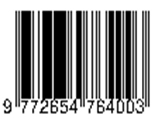PERAWATAN RONGGA MULUT PASIEN BELL’S PALSY: LAPORAN KASUS
Abstract
Keywords
Full Text:
PDF (Bahasa Indonesia)References
Adam OM. Bell’s palsy. Jurnal Ilmiah Kedokteran Wijaya Kusuma. 2019;8(1):137–49.
Dong SH, Jung AR, Jung J, Jung SY, Byun JY, Park MS, et al. Recurrent Bell’s palsy. Clinical Otolaryngology. 2019 May 1;44(3):305–12.
Zhang W, Xu L, Luo T, Wu F, Zhao B, Li X. The etiology of Bell’s palsy: a review. Vol. 267, Journal of Neurology. Springer; 2020. p. 1896–905.
Lancaster DG, Crow WT. Osteopathic Manipulative Treatment of a 26-Year-Old Woman With Bell’s palsy. JAOA. 2006;106(5):285–9.
Diane P. Kandray RMe. Treating Patients with Bell’s palsy [Internet]. https://dimensionsofdentalhygiene.com/article/treating-patients-with-bells-palsy/. 2014. [Cited 12 Dec]
Hartiningtyas. Studi Penggunaan Vitamin B1, B6, dan B12 pada Pasien Guillain Barre Syndrome (GBS) [Skripsi]. [Surabaya]: Fakultas Farmasi Universitas Airlangga; 2014.
Koirala KP. Epidemiological Study of Bell’s palsy in patients From Western Nepal. Eastern Green Neurosurgery. 2020 Jun 4;2(2):41–6.
Mustafa AHK, Sulaiman AM. The Epidemiology and Management of Bell’s palsy in the Sudan. Open Dent J. 2018 Oct 25;12(1):827–36.
Warner MJ, Hutchison J, Varacallo M. StatPearls Publishing. 2023. Bell’s palsy.
Nisa Islamiati E, Nia Irasanti S, Kusmiati M, Hikmawati D, Nur IM. Karakteristik Nevus Pigmentosus berdasar atas Gambaran Histopatologi di Rumah Sakit Al-Islam Bandung. Jurnal Integrasi Kesehatan & Sains (JIKS). 2019;1(1):79–82.
CDHO. College of Dental Hygienists of Ontario. 2014. Bell’s palsy.
Greenberg M, Glick M, Ship JA. Burket’ s Oral Medicine. 11th ed. 2008.
Barakian Y, Vahedi M, Sadr P. Exfoliative Cheilitis: A Case Report. Avicenna Journal of Dental Research. 2015 Sep 16;7(2):1–1.
Ragunathan M, Herawati E, Epsilawati L. Gambaran klinis dan faktor predisposisi dari coated tongue pada mahasiswa gigi klinik Fakultas Kedokteran Gigi Universitas Padjadjaran. Jurnal Radiologi Dentomaksilofasial Indonesia (JRDI). 2020 Jan 15;3(3):17.
Nur’aeny N, Wahyuni IS, Hidayat W. Gambaran Coated Tongue di Masyarakat. 2018.
Reamy B V, Derby R, Col L, Bunt CW. Common Tongue Conditions in Primary Care. Am Fam Physician. 2010 Mar 1;81(5):627–34.
Bhat Z, Rizwan Hamid, Bashir Wani, Altaf Chalkoo. Fissured tongue: A cross-sectional study. International Journal of Applied Dental Sciences. 2018;4(3):133–5.
Rathee M, Hooda A, Kumar A. Fissured Tongue: A Case Report and Review of Literature. Vol. 10, The Internet Journal of Nutrition and Wellness. 2009.
Ashok N, Dr. Geon Pauly. The Gruesome Grooves: Fissured Tongue – A Case Report. ARC Journal of Dental Science. 2019;4(1).
Elmezwghi AM, Elsagali AH, Ftis WK, SMO S, El-kakalli NM. Prevalence association of
fissured tongue with the most common medical conditions in a sample of Libyan population: A cross-sectional study. International Journal of Applied Dental Sciences. 2021 Apr 1;7(2):147–54.
Owczarek JE, Lion KM, Radwan-Oczko M. Manifestation of stress and anxiety in the stomatognathic system of undergraduate dentistry students. Journal of International Medical Research. 2020 Feb 1;48(2).
Langlais RP, Miller CS, Nield-Gehrig J. Color Atlas of Common Oral Disease. 2000.
Rama Dona R. Laki-laki 45 Tahun dengan Bells Palsy. Lampung; 2015 Dec.
DOI: https://doi.org/10.33854/jbd.v10i2.1497
DOI (PDF (Bahasa Indonesia)): https://doi.org/10.33854/jbd.v10i2.1497.g511
Refbacks
- There are currently no refbacks.
Copyright (c) 2023 Nanan Nur'aeny

This work is licensed under a Creative Commons Attribution-NonCommercial-ShareAlike 4.0 International License.




